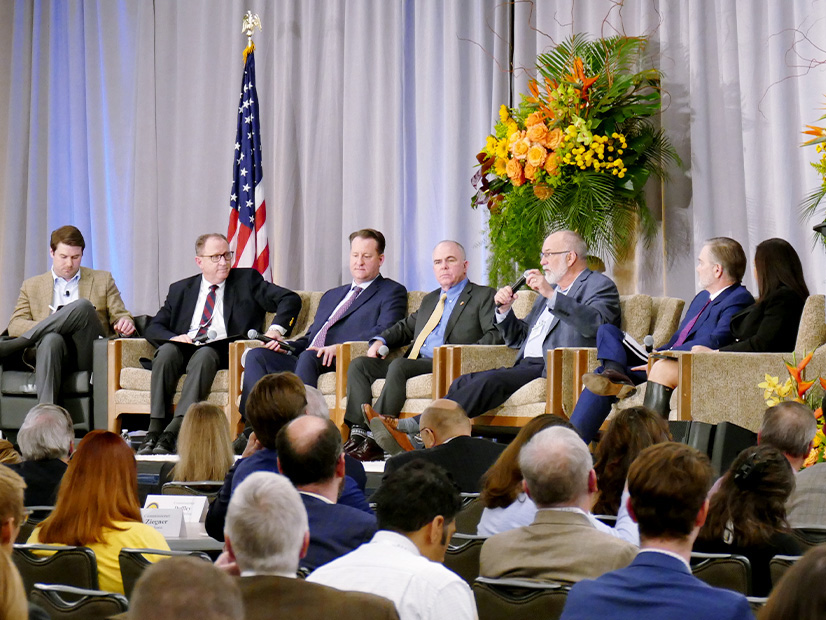
WASHINGTON — Despite making progress after repeated high-profile winter reliability events, the gas and electric industries still have more work to do to coordinate their operations enough to avoid such incidents in the future, experts said at the National Association of Regulatory Utility Commissioners’ Winter Policy Summit Monday.
Winter Storm Uri in February 2021 and Winter Storm Elliot in December 2022 each presented the power and gas sectors with a different set of problems, according to MISO President and COO Clair Moeller.
But Moeller said the events shared a common thread: Those problems were rooted in a continued disconnect between the industries — one stemming from difference in how they operate.
“Electricity is ‘N minus one’ forever,” he said, referring to the power industry’s “N-1” reliability criterion, which holds that the grid must be equipped in a way that it can lose a major resource or transmission line without threatening electricity supply. “Gas is like, ‘You know, pipes don’t fail very often, so maybe it’s not worth those investments.’”
The gas industry has been more focused on the commodity itself rather than ensuring resilient operations because nobody has paid it to provide the latter, he said.
“Just to make it more fun in the planning horizon, we’re asking them to become intermittent resources, the reciprocal of renewables, to fill all those holes, and at the same time, we’re electrifying, taking their base load,” Moeller said. “So, the planning problem here is enormous.”
The differing business models makes it difficult to figure out whom to talk to in order to bridge the differences between the two industries, Moeller said. And even within the gas industry, the pipelines have their own issues, which are different from the local delivery companies and natural gas suppliers.
“There really isn’t a very good place to talk about it except here, which is why I bring it up,” Moeller said. “It’s time; the penetration of renewables is accelerating. We’re relying on gas to be that reciprocal intermittency. But we haven’t told them what that looks like, and we haven’t shown up with a checkbook to make sure that they can do it.”
After experiencing the polar vortex of 2014 and helping its neighbors get through Uri, PJM Senior Vice President of Operations Michael Bryson said he thought his RTO had achieved good coordination with the gas industry.
“I think we found out during Elliot that there were certainly gaps in what we were able to see in terms of availability,” Bryson said.
PJM’s load forecast was off by about 10% as it was not ready for the rapid temperature drop over the Christmas holiday weekend, but it also ran into plenty of outages of gas-fired plants that its operators were unaware of until they tried to dispatch the units, he added.
“We actually had, in fact, during Elliot, what I would consider the golden ticket of capacity performance gas: firm transportation, firm supply, no notice scheduling,” Bryson said. “We had units with that, that were curtailed.”
PJM does not have visibility into the operational issues natural gas suppliers might be running into during extreme weather, and that could be fixed by requiring similar information sharing between the gas and electric industries as the RTO does with its neighboring grid operators, he said.
Post-Uri Reforms in ERCOT
Texas has been working on reforms to its power market since Uri knocked out about 50,000 MW of its generation, plunging the state into blackouts that lasted for five days and causing hundreds of deaths and billions of dollars in damages. They include mandatory winterization standards that can be enforced with fines of $1 million per violation per day, said Public Utility Commission of Texas Commissioner Lori Cobos.
“We’ve also developed a first-in-class, first-in-the-country new firm fuel product to help ensure winter resiliency when fuel availability issues arise,” Cobos added.
The PUC authorized ERCOT to procure up to 3,000 MW for the new firm fuel product, and it signed up 19 power plants, 18 of which can burn fuel oil with storage onsite, while the other has a direct pipeline connection to its own natural gas storage facility. All the generators can provide power for up to 48 hours.
ERCOT used the firm fuel product for the first time during Winter Storm Elliot just before Christmas, calling up eight generators that supplied 950 MW, Cobos said.
While the product provided some guaranteed generation, the PUC still is looking into the 13,000 MW of generation that went offline during Elliot, specifically whether any had weatherization issues, she said.
Gas-fired generation has grown at the expense of coal because it is cleaner, but it cannot be stored. And now the electric industry is relying on the gas industry to meet needs the gas system was never designed for, said Chris Moser, head of competitive markets and policy at NRG Energy (NYSE:NRG).
“The gas system itself is well-built; the electric system itself is well-built. The combination of those two systems, frankly, is brittle,” Moser said. “And it’s the touchpoints in between the two of them, some of them just on a daily basis, where things start to break down.”
The issues are exacerbated during winter storms, when spot prices for natural gas spike to above $100/MMBtu, which leads to generator bids above the price cap in many markets. Uri saw prices reach $1,200/MMBtu on the border of Texas and Oklahoma despite the region’s vast supplies of natural gas, said Moser.
When gas is just $4 or even $10/MMBtu, generators can deal with it, but once prices get into the hundreds that can “sink an entire company,” Moser said.


